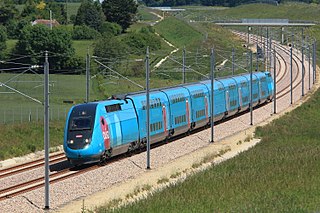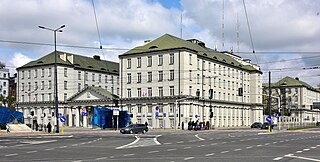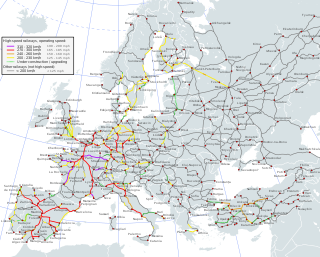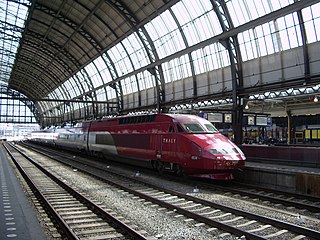Related Research Articles

Thalys was, until September 2023, the commercial name of certain high-speed train services in western Europe, operated by the Eurostar Group from April 2022, and by Thalys International before that. The services connect Paris and Brussels, and extend to either Amsterdam or to German cities in the Rhein-Ruhr, including Aachen, Cologne, Düsseldorf, Duisburg, Essen and Dortmund. Since 29 September 2023 the services have used the common brand name "Eurostar", and are sometimes referred to as Eurostar Red, the colour of the trains.

ProRail is a Dutch government organisation responsible for the maintenance and extension of the national railway network infrastructure, the allocation of rail capacity, and controlling rail traffic. Prorail is a part of NS Railinfratrust, the Dutch railway infrastructure owner.

Nederlandse Spoorwegen is the principal passenger railway operator in the Netherlands. It is a Dutch state-owned company founded in 1938. The Dutch rail network is the busiest in the European Union, and the third busiest in the world after Switzerland and Japan.

The HSL-Zuid, is a 125 kilometre-long Dutch high-speed railway line running between the Amsterdam metropolitan area and the Belgian border, with a branch to Breda, North Brabant. Together with the Belgian HSL 4 it forms the Schiphol–Antwerp high-speed railway. Originally scheduled to be in service by 2007, the first public operations began on 7 September 2009, after a ceremony on 6 September.

Amsterdam Zuid is a railway station situated in the borough of Amsterdam-Zuid in Amsterdam, Netherlands. For a number of years, it was named Amsterdam Zuid WTC, in reference to the neighbouring World Trade Center Amsterdam. During 2006, in conjunction with the rapid development of the area surrounding the station, the station was enlarged and the reference to the WTC was formally dropped from the name.

The LGV Bretagne-Pays de la Loire is a French high-speed rail line running between Connerré, Sarthe near Le Mans and Cesson-Sévigné, Ille-et-Vilaine near Rennes.

PKP Polskie Linie Kolejowe S.A. is the Polish railway infrastructure manager, responsible for maintenance of rail tracks, conducting the trains across the country, scheduling train timetables, and management of railway land.

The HSL 4 is a Belgian high-speed rail line part of the 87 kilometres (54 mi) axis which connects Antwerp to the Dutch border. It is 40 kilometres (25 mi); 36 kilometres (22 mi) of it being dedicated high speed tracks. It was scheduled for completion by 2005 and opened in 2009.

Infrabel is a Belgian government-owned public limited company. It builds, owns, maintains and upgrades the Belgian railway network, makes its capacity available to railway operator companies, and handles train traffic control.

Belgium's high-speed rail network provides mostly international connections from Brussels to France, Germany and The Netherlands. The high-speed network began with the opening of the HSL 1 to France in 1997, and since then high-speed lines have been extended towards Germany with HSL 2 in 2002, HSL 3 from Liège to the German border in 2009, and HSL 4 from Antwerp to the Dutch border in 2009.

In February 2009, the government of Portugal announced plans to build a high-speed rail line from Lisbon to Madrid; this plan was cancelled in March 2012 amidst a bailout programme of financial assistance to the Portuguese Republic. The project was valued at €7.8 billion and the government had claimed it would create 100,000 jobs. The line would link to Spain's Southwest Corridor.

Rail transport in the Netherlands uses a dense railway network which connects nearly all major towns and cities. There are as many train stations as there are municipalities in the Netherlands. The network totals 3,223 route km (2,003 mi) on 6,830 kilometres (4,240 mi) of track; a line may run both ways, or two lines may run on major routes. Three-quarters of the lines have been electrified.
The Norwegian National Rail Administration was a government agency responsible for owning, maintaining, operating and developing the Norwegian railway network, including the track, stations, classification yards, traffic management and timetables. Safety oversight was the duty of the Norwegian Railway Inspectorate, while numerous operating companies run trains on the lines; the largest being the state owned passenger company Vy and the freight company CargoNet.

Rijkswaterstaat, founded in 1798 as the Bureau voor den Waterstaat and formerly translated to Directorate General for Public Works and Water Management, is a Directorate-General of the Ministry of Infrastructure and Water Management of the Netherlands. Its role is the practical execution of the public works and water management, including the construction and maintenance of waterways and roads, and flood protection and prevention. The agency was also involved in the construction of big railway projects such as the Betuweroute and the HSL-Zuid.
Royal BAM Group nv is a Dutch construction-services business with headquarters in Bunnik, Netherlands. It is the largest construction company based on revenue in the Netherlands.

High-speed rail (HSR) has developed in Europe as an increasingly popular and efficient means of transport. The first high-speed rail lines on the continent, built in the 1970s, 1980s, and 1990s, improved travel times on intra-national corridors. Since then, several countries have built extensive high-speed networks, and there are now several cross-border high-speed rail links. Railway operators frequently run international services, and tracks are continuously being built and upgraded to international standards on the emerging European high-speed rail network.

The John Holland Group is an infrastructure, building, rail and transport business operating in Australia and New Zealand. Headquartered in Melbourne, it is a subsidiary of China Communications Construction.

The Trenitalia ETR 700, originally NS Hispeed V250, is a high-speed train designed by Pininfarina and built by AnsaldoBreda originally for NS International and NMBS/SNCB to operate on the Fyra service, a high speed train between Amsterdam and Brussels with a branch to Breda on the newly built HSL-Zuid in the Netherlands and its extension HSL 4 in Belgium.

High-speed rail service in the Netherlands started at 13 December 2009 with the dedicated HSL-Zuid line that connects the Randstad via Brussels to the European high-speed rail network. In later years improved traditional rail sections were added to the high-speed network. Proposals for more dedicated high-speed lines were deemed too costly; plans for the HSL-Oost to Germany were mothballed and instead of the Zuiderzeelijn the less ambitious Hanzelijn was built to enable future high-speed service between the northern provinces and the Randstad.

The National Railway Infrastructure Company is Bulgaria's state railway infrastructure company, established as an entity on 1 January 2002. The company's headquarters are located in the capital city Sofia near Sofia Central Station. It is the owner and operator of most of the country's rail lines.
References
- ↑ Sources:
- "Infraspeed", www.prorail.nl (in Dutch), ProRail, archived from the original on 10 May 2012, retrieved 21 March 2012
- "Infraspeed the InfraProvider for HSL-South" (PDF), 1st International Seminar on Railway Operations Modelling and Analysis, Delft, The Netherlands, Journal of Railway Operations Research, June 2005[ permanent dead link ], First presentation
- "Infraspeed de InfraProvider voor HSL-Zuid" (PDF), 1st International Seminar on Railway Operations Modelling and Analysis, Delft, The Netherlands, Journal of Railway Operations Research, June 2005[ permanent dead link ], Second presentation
- 1 2 Infraspeed company website, www.infraspeed.nl, March 2012.
- 1 2 3 4 5 6 7 8 9 10 11 "HSL-Zuid: high-speed importance". globalrailwayreview.com. 8 April 2008.
- ↑ "Infraspeed wins HSL-Zuid PPP". Railway Gazette International. 1 June 2001.
- ↑ "HSL Zuid: rail becomes reality". ijglobal.com. 1 December 2001.
- 1 2 3 4 5 6 "HSL-Zuid: ready, steady, go!". globalrailwayreview.com. 6 February 2007.
- ↑ Abst, S.; Fiegl, B.; Fihlon, M.; Puschmann, Rainer (November 2007). "Electrification of the HSL Zuid high-speed line in the Netherlands". pp. 46–57.
- ↑ Hughes, Murray (1 April 2005), "Contractors hurry to finish HSL-Zuid", www.railwaygazette.com, Railway Gazette International
- ↑ "Holland's landmark PPP high speed rail project". railtechnologymagazine.com. 1 March 2007.
- ↑ "Beneficial monitoring: not whether, but when?". globalrailwayreview.com. 26 September 2007.
- ↑ Vosman, Quintus (8 March 2018). "Conventional trains causing excessive track wear on HSL South, claims Infraspeed". International Railway Journal.